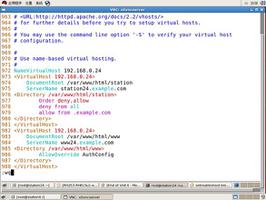LearntoUseCURLCommandinLinuxWithTheseExamples

CURL works with every protocol you might have used. Head over this site to check whether CURL works with your target protocol or not.
What CURL can do?
Hmm… Everything that is related to data transfer. Everyone must have used a browser. Even now, you are reading this article through your browser. What browser does, it requests a page and gets it as a response. It can write and read cookies. And then it renders(displaying the content, images and executing JS scripts) it.
CURL can do everything a browser except for the last part rendering because it is not related to data transfer.
As wrap up, CURL can download HTML pages, fill HTML forms and submit them, download files from a FTP/HTTP server and upload files to the same and read/write cookies.
This makes it an excellent tool to be used in scripting, debugging and forensic analysis etc.
Curl command examples
Let’s see what can you do with Curl.
1. Get a response from a server
Everything from server is a response to the request. So getting a HTML page is same as downloading a file.
To get a HTML response from http://info.cern.c,
curl http://info.cern.ch/To get the list of posts as a response from a server ( https://jsonplaceholder.typicode.com/posts),
curl https://jsonplaceholder.typicode.com/postsSince we know how to get a response from a server, you can download a file ( say Google logo ).
curl https://www.google.com/images/branding/googlelogo/1x/googlelogo_color_272x92dp.pngAbove command will dump binary image data which you can’t view in the terminal. You need to save them and then use a photo viewer to see them. Continue reading to find out how to do so.
Note that various option flags can be placed anywhere on the command instead of the strict ordering. So no worry if you placed any option in the last while the examples had the flag in the beginning.
2. Save the file with a default file name
Every file that is served on the internet has a filename. To use the same filename as the downloaded filename use -O flag.
curl -O http://www.google.com/robots.txt3. Save the file with custom name
To save the filename with your own custom name, use -o flag followed (strictly) by a custom name.
curl -O http://www.google.com/robots.txt googleRobots.txt
4. Download multiple files
To download multiple files, separate them with a white space.
curl url1 url2 url3If you want to use -O flag for all the URL’s, use
curl url1 url2 url3 -O -O -O The same workaround should be done for any flag. This is because the first occurrence of a certain flag is for the first URL, the second flag is for the second URL and so on.
5. Download a range of files
curl has the in-built ability to download a range of files from the server. This can be illustrated from the following example.
curl http://www.google.com/logo/logo[1-9].pngAbove command downloads files from logo1.png, logo2.png, logo3.png and up to logo9.png.
6. Download a file only if latest
To download a file only if the file’s modification time is latest than the given time.
curl url -z "DD MMM YY MM:HH:SS"7. Resume Downloading
If you have already partially transferred a file, you can resume the transfer by using the -C flag. Offset from which transfer needs to be continued should be passed as a parameter to the -C flag.
curl -C 1024 http://seeni.linuxhandbook.org/files/largeFile.mpv -O8. Upload a file
To upload a file to the server, one needs to use -T flag followed by the file path on your local system.
curl -T uploadFile.txt http://upload.linuxhandbook.org/files9. Delete a file
To delete a file named deleteFile.txt in a server, one can use -X flag which is intended for any HTTP verb/method(like GET, POST, PUT, DELETE, PATCH). Most of the FTP servers will have configured DELETE method if not all advanced HTTP methods.
curl -X DELETE http://upload.linuxhandbook.org/files/deleteFile.txtYou can also modify the above command for any HTTP method to do the corresponding task. For Example, if your server allows TRUNCATE method ( this is made-up HTTP method, not a standard one) which removes only the content in the file and not the file, one can use the command similar to the below one.
curl -X TRUNCATE http://upload.linuxhandbook.org/files/mysql.dumpAbove mentioned are the main uses of curl. But there might be difficulties which needed to be fought such as redirects, user authentication, SSL certificates, etc., We can call them add-ons as they are only optional but still remain crucial for certain purposes. Let’s see some of those addons and how to handle it with curl in the next section.
10. Avoid redirects
When you request htttp://www.google.com , you will be served only the regional page such as www.google.co.in. This is done with the help of redirects (HTTP packets with status codes in the range 300-399).
You can avoid redirects with the option L.
curl -L htttp://www.google.com11. Authentication
When the server is configured to serve for only certain individuals with credentials, they will be provided with username and password. One can make login with the help of -u flag.
curl -u username:password http://seeni.linuxhandbook.org/files/tasks.txt12. Limit data transfer
If you want to impose a data transfer limit use –limit-rate flag. Following command tries to download the file with rate limit as 10K.
curl --limit-rate 10K http://seeni.linuxhandbook.org/files/logoDetails.tgz13. Show/Hide transfer Status
If the response is redirected from the terminal such as downloading, uploading then curl automatically shows the status/progress meter for the transfer.
If you do not want to see the progress meter, just append the command with -s flag. Progress will not be shown for response directed for the terminal.
14. Ignore SSL certificates
Do you remember the situations in which you need to give security certificate exception to visit some websites? If you trust the sources and you want to do a data transfer, you can ignore SSL certificate validation by using -k flag.
curl -k https://notSoSecure.org/files/logoDetails.tgz15. Get Header Information also
To display the header information along with transferred data, use the -i flag.
curl -i http://www.google.com/robots.txt16. Get Header information Only
If you want only the headers and not the data, use the -I flag
curl -I http://www.google.com/robots.txt17. Change User Agent
Some websites and servers don’t allow certain kinds of devices to access their systems. But how do they know that we are using a specific kind of device? This is due to the User-Agent HTTP header field. We can change this User Agent with -A flag.
curl -A "Mozilla FireFox(42.0)" http://notAllowedForCLI.sites.org/randomFile.png18. Sending data to the Server
If the server needs some data such as token or API key, use -d flag to send the data. Data that needs to be sent should follow the flag in the command. One can use “&” to combine multiple data. This is usually done by GET and POST requests in browsers. This is one of the ways by which you can send your form information.
curl -d "token=34343abvfgh&name="seeni"" http://api.restful.org/getcontent19. Write Cookies to a File
Cookies are some small information that allows maintaining a session with a stateless HTTP protocol. If you want to know more about Cookies, refer to this great resource.
To write cookies to a file, -c flag followed by the cookie filename should be used.
curl -c googleCookie.txt http://www.google.com/files20. Reading Cookies from a File
To read a cookie from the file, -b flag followed by cookie filename can be used.
curl -b googleCookie.txt http://www.google.com/filesNote that -b flag only reads the cookie from the file. So if the server resends another cookie, you might need to use -c option to write them.
21. Start a new Session
If you want to initiate a new session by discarding the cookies, use -j flag. It starts a new session even if you have provided the cookie file to read with -b flag.
curl -b googleCookie.txt http://www.google.com/files -jCongratulations! You made it to the end. If you find this article useful, Share it with your friends and follow us on Social media. If you have any suggestions about this article or any other topic, Feel free to drop them below.
以上是 LearntoUseCURLCommandinLinuxWithTheseExamples 的全部内容, 来源链接: utcz.com/z/513000.html









